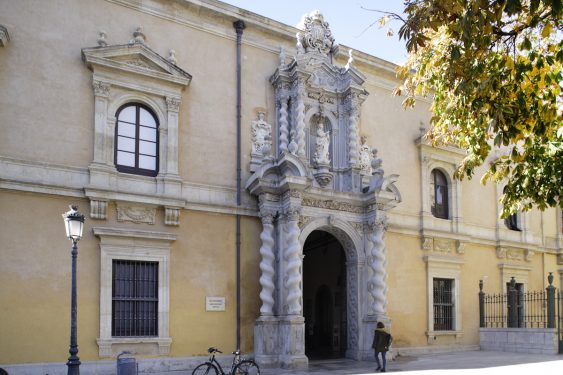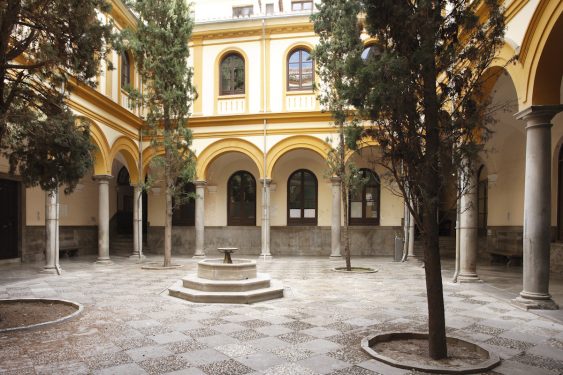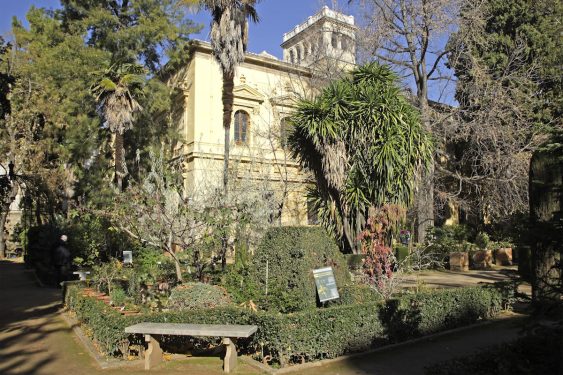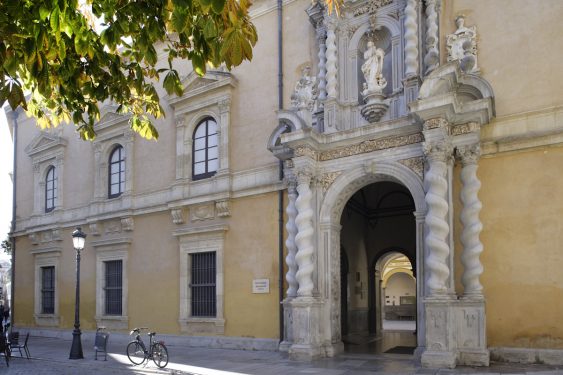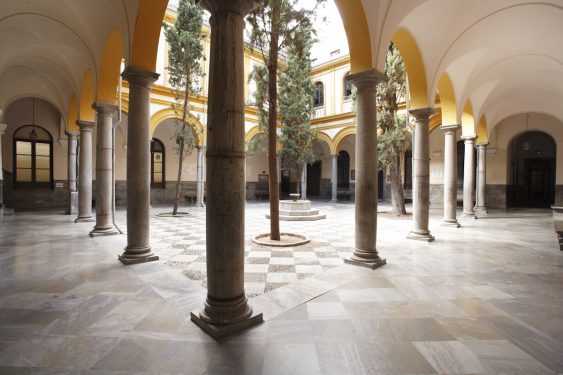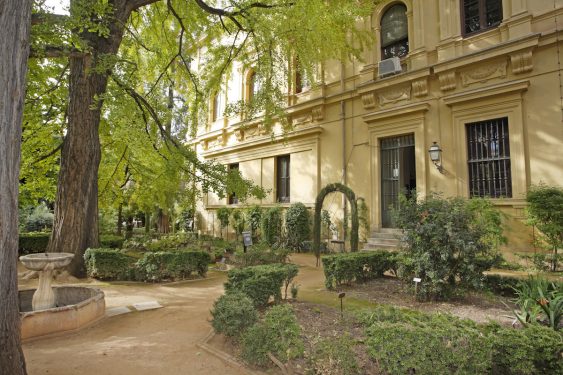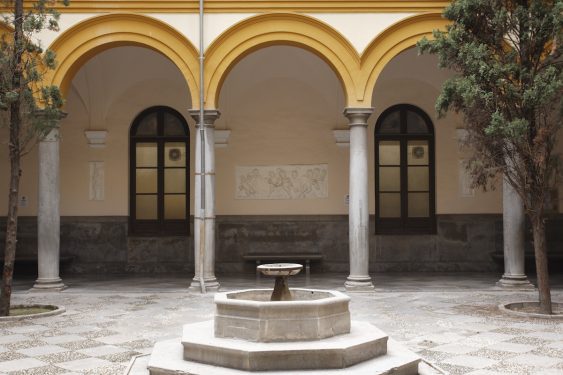Nineteenth century building where Federico studied at university, first Literature and then Law, between 1916 and 1923.
In 1916, after passing the common preparatory course for Arts and Law, Federico García Lorca enrolled at the University of Granada. Although at first he studied both degrees, later, after seeing the increasing difficulties in dealing with certain Arts subjects, he opted for Law, a career in which he graduated more by fortune with certain teachers than by application and perseverance. In this way he ended up pleasing his father who wanted Federico to become a lawyer.
The main entrance of the Law School (Facultad de Derecho) leads to the classrooms where García Lorca studied. The rear entrance, on Duquesa Street, was separated from the academic area and in 1936 incorporated the Gobierno Civil where Federico was taken after his arrest in the house of the Rosales family on August 16.
Federico’s law career advanced by fits and starts thanks to the “wangled passes” and the determination of Professor Viñuales, who went so far as to request the poet to grade himself.
As an Arts student, the professor who most influenced the poet, less for his use of the classes than for the complementary activities, was Martín Domínguez Berrueta, professor of Theory of Arts and Literature. Don Martín, influenced by the Free Teaching Institution, established a close relationship with his students at his house in Tinajilla Street, and organized a series of study trips from 1913 onwards that allowed Federico to visit Baeza and meet Machado or visit Castilla. They also visited different monuments in Granada, such as Santa Isabel la Real. However, the version given by Mora Guarnido of Martín Domínguez as a professor has nothing to do with the image of a man ahead of his time and a traveler. “Don Martín was nothing more than a parody of a professor. His cheap histrionics and his vanity pushed him to disproportionate and exalted attitudes, to hollow dithyrambs never strengthened by an exact criterion,” writes Mora in his memoirs. The experience served Lorca to gather material for his first book Impressions and Landscapes (1918).
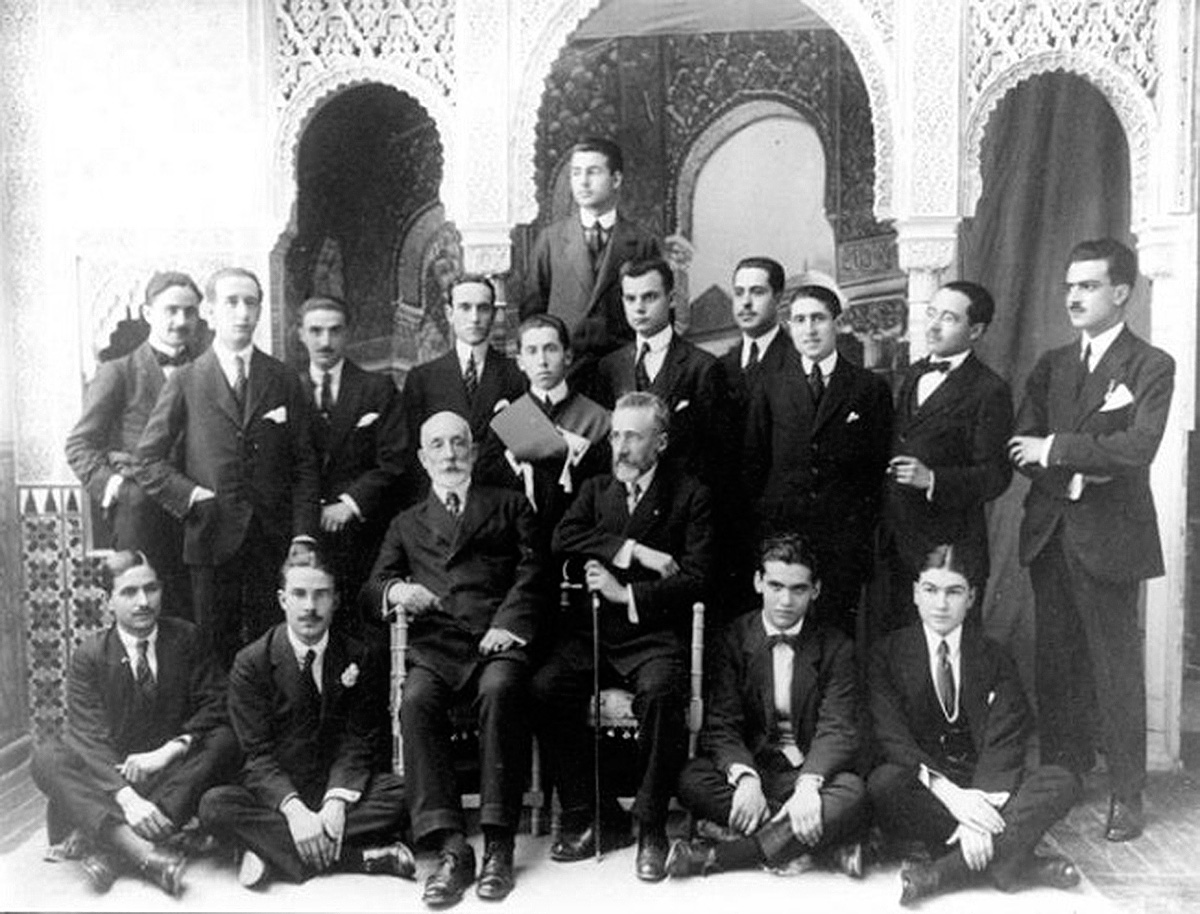
.Federico’s stay at the University, already focused only on law, coincided with the academic renewal of the institution. One of the first young professors was Fernando de los Ríos, linked for family reasons to the Free Teaching Institution, who taught Constitutional Law, and Agustín Viñuales.
García Lorca’s career advanced by leaps and bounds thanks to the “wangled passes” in subjects such as Canon, Civil or Private Law and the determination of Professor Viñuales, who went so far as to request the poet to grade himself in the subject of Public Finance. Another of Federico’s bones of contention was Criminal Law, which he saved thanks to an impromptu answer he gave on the death penalty to Professor Antonio Mesa Moles.

The last stone he had to dodge was Commercial Law. The professor let it be known that since it was the year of his retirement, Federico’s exam would be the last of his professional life. Lorca presented himself in a special convocation, alone and without an audience. “He was passed,” says his brother Francisco, but he no longer wanted to “broach the subject of his studies.”
Federico participated in two of the famous internship trips organized by Martín Domínguez Berrueta in Spain. The trips were made possible by a meager ministerial grant awarded to his professorship from Madrid. The itineraries, a sort of end-of-year celebration, were preceded by a complex selection process. The trip, which also included Don Martín’s family, covered Andalusia, Castile and Extremadura, i.e. the itinerary that Lorca captured in Impressions and Landscapes. According to Mora Guarnido, every year it changed its name, but it was invariable: Itinerary of the Ballads, Itinerary of the Cid, Itinerary of Don Quixote.
In addition, Don Martín had everything planned so that the trip would terminate in Salamanca, his homeland, where in the midst of a veritable apotheosis, described the next day in the chronicles of the Salamanca newspaper El Adelanto, the travelers were received by the bishop, the governor, the mayor and even Miguel de Unamuno. “There were receptions and abundant events, including artistic and literary ones, honorary functions, serenades and banquets.”
In Law, the professor who most influenced Lorca, not only as a lecturer but also as a friend and advisor, was Fernando de los Ríos, ideologist of humanist socialism opposed to revolutionary socialism, who as Minister of Public Instruction during the Second Spanish Republic was to launch the theatrical dissemination project La Barraca.
The liberality of Fernando de los Ríos was an exception in a Law School where the old and conservative forms prevailed. In contrast to his reformist thinking, in the corridors of the same school there were many people like Andrés Manjón who, apart from founding the Ave María del Sacromonte Schools, had, according to Mora Guarnido, an “intransigent, inquisitorial and merciless” behavior towards the students. The priest began classes by forcing the students to pray and then made “idiotic jokes about Juan Jacobo Ro-us-se-a-a-u…”.
Entramos en clase,
[We go into class,]
me siento en un banco;
[I sit down;]
“a ver, lea sus notas”,”
[Let’s see, read your notes,”]
dice don Fernando…
[says Don Fernando …]
Y yo, ruboroso,
[And I, blushing,]
con miedo borroso,
[with blurred fear,]
la Constitución
[start to read]
de la Nueva Rusia
[the Constitution]
me pongo a leer
[of New Russia]
y un disparatón
[and nonsense]
ha salido de mis labios sin querer.
[accidentally left my lips.]
Entonces noté
[Then I noticed]
que Fernando de los Ríos
[that Fernando de los Ríos]
me miró
[looked at me]
Como no tengo ‘cultura general’
[As if I don’t have a ‘general culture’]
pasó lo que pasó.
[what happened happened.]
- Francisco García Lorca. Federico and his World. Alianza Tres, Madrid, 1990
- Ian Gibson. In Granada, his Granada. Plaza. Barcelona, 1989.
- Jacinto S. Martín. García Lorca Bachelor. Alhulia. Granada, 1998
- José Mora Guarnido. Federico García Lorca and his World. Losada. Buenos Aires, 1958.
- Lorca´s location
- Law School
- current location
- Law School
- ADDRESS
- Plaza de la Universidad, 1
- Web
- http://derecho.ugr.es/web/
- DETAILS OF THE VISIT
Open during the academic year during school hours. Access to the interior courtyards is free.
